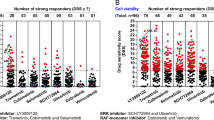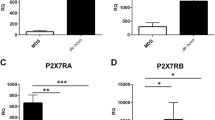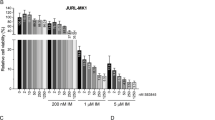Abstract
Several receptor tyrosine kinases (TKs) are involved in the pathogenesis of acute myeloid leukemia (AML). Here, we have assessed the expression of the Recepteur d’Origine Nantais (RON) in leukemic cell lines and samples from AML patients. In a series of 86 AML patients, we show that both the full length and/or the short form (sf) of RON are expressed in 51% and 43% of cases, respectively. Interestingly, sfRON is not expressed in normal CD34+ hematopoietic cells and induces part of its oncogenic signaling through interaction with the Src kinase Lyn. sfRON-mediated signaling in leukemic cells also involves mTORC1, the proapoptotic bcl2-family member, BAD, but not the phosphatidylinositol 3-kinase/Akt pathway. Furthermore, the expression of sfRON was specifically downregulated by 5-azacytidine (AZA). Conversely, AZA could induce the expression of sfRON in sfRON-negative leukemic cells suggesting that the activity of this drug in AML and myelodysplastic syndromes could involve modulation of TKs. cMET/RON inhibitors exhibited an antileukemic activity exclusively in AML samples and cell lines expressing sfRON. These results might support clinical trials evaluating cMET/RON inhibitors in AML patients expressing sfRON.
This is a preview of subscription content, access via your institution
Access options
Subscribe to this journal
Receive 12 print issues and online access
$259.00 per year
only $21.58 per issue
Buy this article
- Purchase on Springer Link
- Instant access to full article PDF
Prices may be subject to local taxes which are calculated during checkout







Similar content being viewed by others
References
Kelly LM, Gilliland DG . Genetics of myeloid leukemias. Annu Rev Genomics Hum Genet 2002; 3: 179–198.
Nakao M, Yokota S, Iwai T, Kaneko H, Horiike S, Kashima K et al. Internal tandem duplication of the flt3 gene found in acute myeloid leukemia. Leukemia 1996; 10: 1911–1918.
Sanz M, Burnett A, Lo-Coco F, Lowenberg B . FLT3 inhibition as a targeted therapy for acute myeloid leukemia. Curr Opin Oncol 2009; 21: 594–600.
Dos Santos C, Demur C, Bardet V, Prade-Houdellier N, Payrastre B, Recher C . A critical role for Lyn in acute myeloid leukemia. Blood 2008; 111: 2269–2279.
Wagh PK, Peace BE, Waltz SE . Met-related receptor tyrosine kinase Ron in tumor growth and metastasis. Adv Cancer Res 2008; 100: 1–33.
Gaudino G, Follenzi A, Naldini L, Collesi C, Santoro M, Gallo KA et al. RON is a heterodimeric tyrosine kinase receptor activated by the HGF homologue MSP. EMBO J 1994; 13: 3524–3532.
Angeloni D, Danilkovitch-Miagkova A, Ivanova T, Braga E, Zabarovsky E, Lerman MI . Hypermethylation of Ron proximal promoter associates with lack of full-length Ron and transcription of oncogenic short-Ron from an internal promoter. Oncogene 2007; 26: 4499–4512.
Bardella C, Costa B, Maggiora P, Patane S, Olivero M, Ranzani GN et al. Truncated RON tyrosine kinase drives tumor cell progression and abrogates cell-cell adhesion through E-cadherin transcriptional repression. Cancer Res 2004; 64: 5154–5161.
Leonis MA, Thobe MN, Waltz SE . Ron-receptor tyrosine kinase in tumorigenesis and metastasis. Future Oncol 2007; 3: 441–448.
Dussault I, Bellon SF . From concept to reality: the long road to c-Met and RON receptor tyrosine kinase inhibitors for the treatment of cancer. Anticancer Agents Med Chem 2009; 9: 221–229.
Persons DA, Paulson RF, Loyd MR, Herley MT, Bodner SM, Bernstein A et al. Fv2 encodes a truncated form of the Stk receptor tyrosine kinase. Nat Genet 1999; 23: 159–165.
Recher C, Beyne-Rauzy O, Demur C, Chicanne G, Dos Santos C, Mas VM et al. Antileukemic activity of rapamycin in acute myeloid leukemia. Blood 2005; 105: 2527–2534.
Gallay N, Dos Santos C, Cuzin L, Bousquet M, Simmonet Gouy V, Chaussade C et al. The level of AKT phosphorylation on threonine 308 but not on serine 473 is associated with high-risk cytogenetics and predicts poor overall survival in acute myeloid leukaemia. Leukemia 2009; 23: 1029–1038.
Christensen JG, Burrows J, Salgia R . c-Met as a target for human cancer and characterization of inhibitors for therapeutic intervention. Cancer Lett 2005; 225: 1–26.
Zhao S, Konopleva M, Cabreira-Hansen M, Xie Z, Hu W, Milella M et al. Inhibition of phosphatidylinositol 3-kinase dephosphorylates BAD and promotes apoptosis in myeloid leukemias. Leukemia 2004; 18: 267–275.
Perl AE, Carroll M . Exploiting signal transduction pathways in acute myelogenous leukemia. Curr Treat Options Oncol 2007; 8: 265–276.
Chen YQ, Fisher JH, Wang MH . Activation of the RON receptor tyrosine kinase inhibits inducible nitric oxide synthase (iNOS) expression by murine peritoneal exudate macrophages: phosphatidylinositol-3 kinase is required for RON-mediated inhibition of iNOS expression. J Immunol 1998; 161: 4950–4959.
Brunelleschi S, Penengo L, Lavagno L, Santoro C, Colangelo D, Viano I et al. Macrophage stimulating protein (MSP) evokes superoxide anion production by human macrophages of different origin. Br J Pharmacol 2001; 134: 1285–1295.
Waltz SE, Eaton L, Toney-Earley K, Hess KA, Peace BE, Ihlendorf JR et al. Ron-mediated cytoplasmic signaling is dispensable for viability but is required to limit inflammatory responses. J Clin Invest 2001; 108: 567–576.
Banu N, Price DJ, London R, Deng B, Mark M, Godowski PJ et al. Modulation of megakaryocytopoiesis by human macrophage-stimulating protein, the ligand for the RON receptor. J Immunol 1996; 156: 2933–2940.
Broxmeyer HE, Cooper S, Li ZH, Lu L, Sarris A, Wang MH et al. Macrophage-stimulating protein, a ligand for the RON receptor protein tyrosine kinase, suppresses myeloid progenitor cell proliferation and synergizes with vascular endothelial cell growth factor and members of the chemokine family. Ann Hematol 1996; 73: 1–9.
Choudhary C, Olsen JV, Brandts C, Cox J, Reddy PN, Bohmer FD et al. Mislocalized activation of oncogenic RTKs switches downstream signaling outcomes. Mol Cell 2009; 36: 326–339.
Gioia R, Leroy C, Drullion C, Lagarde V, Etienne G, Dulucq S et al. Quantitative phosphoproteomics revealed interplay between Syk and Lyn in the resistance to nilotinib in chronic myeloid leukemia cells. Blood 2011; 118: 2211–2221.
Acknowledgements
We thank Sophie Allart, Daniel Sapede, Valérie Duplan-Eche, Laure Armengaud and Fatima L’Faqihi from the Imaging and flow cytometry Core Facility of IFR 30, Monique Larroche, Nicole Lhermie, Frederic Lagarrigue and Estelle Saland for technical assistance and Dr Paola Arimondo for helpful discussions. The Center de Ressource Biologique des Hémopathies Malignes de l’INSERM Midi-Pyrénées provided all AML samples. This work was supported by grants from the Ligue Contre le Cancer (comité de la Haute-Garonne) and from the Institut National du Cancer (INCA/DHOS, PLBIO09-267).
Author contributions
CF designed, performed the research, analyzed data; and wrote the paper; CL, FV and JES performed the research; SB collected all clinical data; VDM, CD, CC and ED centralized the cytological review, performed molecular analysis and provided AML samples from the HIMIP collection; BP analyzed data; SM and SR designed the research and analyzed data; CR designed, controlled, analyzed data, and wrote the paper. All authors checked the final version of the manuscript.
Author information
Authors and Affiliations
Corresponding author
Ethics declarations
Competing interests
The authors declare no conflict of interest.
Additional information
Supplementary Information accompanies the paper on the Leukemia website
Rights and permissions
About this article
Cite this article
Fialin, C., Larrue, C., Vergez, F. et al. The short form of RON is expressed in acute myeloid leukemia and sensitizes leukemic cells to cMET inhibitors. Leukemia 27, 325–335 (2013). https://doi.org/10.1038/leu.2012.240
Received:
Revised:
Accepted:
Published:
Issue Date:
DOI: https://doi.org/10.1038/leu.2012.240
Keywords
This article is cited by
-
mTORC1 is a key mediator of RON-dependent breast cancer metastasis with therapeutic potential
npj Breast Cancer (2018)
-
Acute myeloid leukaemia
Nature Reviews Disease Primers (2016)
-
Targeting the PI3K/Akt/mTOR signaling pathway in B-precursor acute lymphoblastic leukemia and its therapeutic potential
Leukemia (2014)



